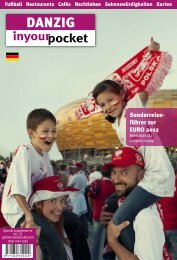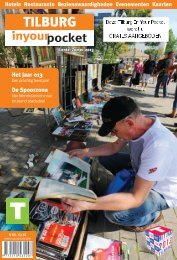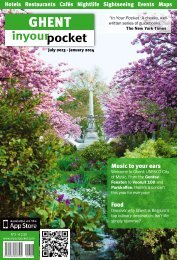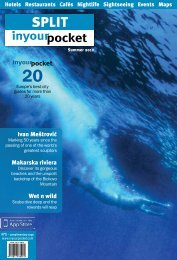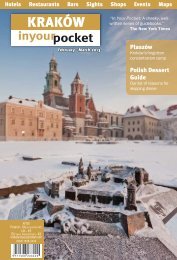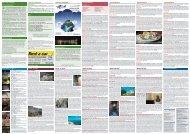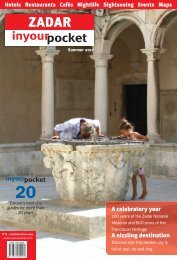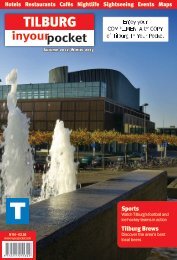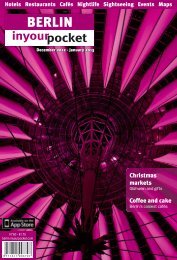7kh 7ul flw\ v prvw dxwkhqwlf 7h[ 0h[ uhvwdxudqw ... - In Your Pocket
7kh 7ul flw\ v prvw dxwkhqwlf 7h[ 0h[ uhvwdxudqw ... - In Your Pocket
7kh 7ul flw\ v prvw dxwkhqwlf 7h[ 0h[ uhvwdxudqw ... - In Your Pocket
Create successful ePaper yourself
Turn your PDF publications into a flip-book with our unique Google optimized e-Paper software.
82 SOLIDARITY<br />
Poles you should know - Lech Wałęsa<br />
Credited as the driving<br />
force behind the<br />
Solidarity movement,<br />
as well as the man<br />
who revived a postcommunist<br />
Poland,<br />
Lech Wałęsa remains,<br />
for many, the public<br />
face of Poland, as well © Stanisław Składanowski<br />
as Gdansk’s most famous<br />
resident.<br />
Born on September 23, 1943 Wałęsa’s early life was<br />
largely anonymous. Working in his early days as a<br />
mechanic it was only in 1967 when he began work at<br />
Gdansk’s Lenin Shipyards that he began his rise to<br />
prominence. A keen trade unionist he frequently found<br />
himself in trouble with the authorities, and his political<br />
activities led to a stint in prison that ultimately cost<br />
him his job.<br />
<strong>In</strong> 1980, with the shipyards on strike, an unemployed<br />
Wałęsa scaled a wall, gave an impromptu speech and<br />
found himself thrust in the spotlight as the accidental<br />
hero of the protests. Having successfully led negotiations<br />
for workers rights it was he who signed the August<br />
Accords of 1980. Ear-marked by the government as an<br />
undesirable influence he was immediately placed under<br />
house arrest when martial law was announced in 1981.<br />
Released a year later, Walesa’s actions were recognized<br />
in 1983 when he was awarded the Nobel Peace Prize.<br />
As the figurehead of the Solidarity movement, and with<br />
the communist state crumbling, Wałęsa led roundtable<br />
talks with the government to formulate a power-sharing<br />
scheme. Partly free elections in 1989 led to blanket wins<br />
for Solidarity, signalling the last days of communism.<br />
<strong>In</strong> 1990 he became Poland’s first democratically elected,<br />
post-communist president, a position he held until 1995.<br />
Although still active in politics, he has seen his influence<br />
wane - the 2000 presidential elections won him little over<br />
1% of the public vote.<br />
<strong>In</strong> recent years his outspoken style and maverick methods<br />
have seen him fall foul of Poland’s intelligentsia;<br />
although an inspirational orator and soapbox politician,<br />
he is notorious for George W. Bush-style blunders, and<br />
his decision to appoint his chauffeur and table-tennis<br />
partner as an advisor in his latter years in power cost<br />
him further credibility.<br />
Having turned down a million dollar offer from Gillette to<br />
shave off his moustache, Wałęsa did the deed himself<br />
a couple of years back in a bid to increase his public<br />
profile as a politician. It failed, and a once again mustached<br />
Wałęsa finds himself on the political sidelines,<br />
eclipsed by his son, Jarosław, one of his eight children,<br />
and currently a member of the European parliament. But<br />
while Wałęsa’s political days are over the anniversary of<br />
the 1980 strikes have seen him catapult back into the<br />
limelight. Since his political retirement he now spends his<br />
days lecturing abroad, averaging some 15 international<br />
visits per year, speaking on subjects close to his heart:<br />
democracy, civil liberty and the free market. The recipient<br />
of over 30 honary doctorates from international universities,<br />
Wałęsa most recently found himself in the headlines<br />
after a ruling confirmed that rumours he was a cold war<br />
spy for the state were no more than scurrilous gossip. <strong>In</strong><br />
fact the courts revealed he was completely the opposite,<br />
and the subject of intense personal survaillance by the<br />
secret services.<br />
Roads to Freedom (Drogi do Wolności) B-1, ul.<br />
Wały Piastowskie 24, tel. (+48) 58 308 44 28, www.<br />
ecs.gda.pl. ‘Many generations to come will remember<br />
the extraordinary thing that happened in Poland, there<br />
appeared a social force able to control those in power.’<br />
Culture magazine, Paris, 1980. This is the second coming<br />
of the Roads to Freedom exhibition and it is a place that<br />
should feature highly on every visitor’s itinerary. Charting<br />
the course of events from 1945 till 1989, this subterranean<br />
exhibition does an excellent job of explaining the meteoric<br />
rise and subsequent consequences of the Solidarity phenomena.<br />
The exhibition kicks off by launching the visitor<br />
into the world of the average Pole circa late 1970s - staring<br />
you in the eye is a diorama depicting a typical grocery<br />
store, it’s shelves empty but for a thin spread of vinegar<br />
and mustard: practically the only goods which weren’t in<br />
scant supply. The stark, cold reality of day-to-day life is<br />
brought home with a thud, the sepia shots of ration queues<br />
dispelling the myth of Utopian paradise. Following this<br />
primer visitors are given a historical background to postwar<br />
communism; not just in Poland, but across Europe.<br />
Themes explored include the rising discontent, and heavy<br />
emphasis is placed on the growing tides of unrest - starting<br />
with the first open rebellion in 1956, the picture builds<br />
to a crescendo by zooming in on December 1970, a time<br />
when 45 people - the majority from the tri-city area - were<br />
killed during clashes with armed forces. Protesting sharp<br />
price increases events took a bloody twist when party<br />
chairman Władysław Gomułka ordered security forces to<br />
intervene, and the ensuing scenes are captured vividly in<br />
the exhibitions on show; among them, camera captures and<br />
video shots of the violence, much of it focused around the<br />
Gdańsk Party HQ (the white building which stands opposite<br />
the town hall on Wały Jagiellońskie). English translations<br />
accompany the footage, while a mock cell based on those in<br />
which protestors would have been detained in provides grim<br />
Gdańsk <strong>In</strong> <strong>Your</strong> <strong>Pocket</strong> gdansk.inyourpocket.com<br />
confirmation of the hardline reaction. The protests of 1970<br />
were a landmark event, but these were just a precursor to<br />
what would follow in 1980. Up next, passing by the head of<br />
the omnipotent Lenin, the tour takes you deep into the time<br />
of the 18 day strike which paralysed the nation, and left the<br />
world on tenterhooks. To a background of rabble-rousing<br />
speeches and strike anthems, visitors can view the original<br />
sheets of plywood on which the demonstrators spelled out<br />
their 21 demands in what would go on to become known<br />
as the ‘August Accords’. Reconstructed is a mock-up of the<br />
room in which negotiations were held, tables topped with<br />
huge transistor radios to tap into news from the outside<br />
world. The creation of the iconic Solidarity logo, as well<br />
as the unifying role of the Catholic church, is also given<br />
detailed mention, and by this stage visitors are left feeling<br />
hopelessly sucked into the heady atmosphere of the time.<br />
Following this, the prescribed tour takes you through the<br />
months of ‘Solidarity and Hope’, an unprecedented time<br />
during which cultural life and social freedom flourished like<br />
never before. The optimism during the 16 months which<br />
followed the events of August 1980 are neatly presented by<br />
way of audio recordings, artwork and photos, a brief respite<br />
from the horror that swiftly follows; accessed through some<br />
rubber curtains the visitor is propelled into the terrifying<br />
world that was Poland, 13 December, 1981. It was on this<br />
watershed day that General Jaruzelski ordered Martial Law,<br />
ordering the army to effectively invade its own country. The<br />
brutality and tension of these times is illustrated by crackly<br />
film reels showing pitch battles with security forces - including<br />
one uncomfortable moment when an army vehicle<br />
smashes straight over a dissident - as well as extras such<br />
riot shields and weaponry used to enforce Martial Law.<br />
Jaruzelski’s speech, the televised decree announcing his<br />
action, loops with gloomy regularity, as if to punch in the<br />
severity of his stance. And yet, in spite of the overwhelming<br />
odds, resistance to the regime continued to rage, and this<br />
is marked by dioramas depicting an underground printing<br />
press, as well assorted anti-establishment exhibits. The<br />
concluding sections include the nation’s historical timeline<br />
from 1944 to 1989 and the final room is the base for temporary<br />
exhibitions which are held regularly.<br />
Truly, Roads to Freedom stands out as one of the finest<br />
museums in Poland - possibly only usurped by the newly<br />
opened Chopin Museum in Warsaw - however, it has not<br />
existed without problems. The exhibition has since moved<br />
from its original home in the historic shipyards, and while<br />
a return to the BHP building in which the August Accords<br />
were signed is unlikely, the exhibition is due to move to the<br />
European Solidarity Centre building when that is completed.<br />
QOpen 10:00 - 18:00. Closed Mon. Admission 6/4zł, Wed<br />
2zł, groups over 10 people 3zł per person, family ticket<br />
10zł. Y<br />
gdansk.inyourpocket.com<br />
Further reading<br />
SOLIDARITY<br />
The Polish Revolution: Solidarity<br />
by Timothy Garton Ash<br />
Winner of the Somerset Maugham Award ‘The Polish<br />
Revolution: Solidarity‘ counts as the seminal work covering<br />
the Solidarity era, and ranks as one of the most<br />
important books written on post-war European history.<br />
As one of a handful of Western journalists based in Poland<br />
throughout the 1980s, Timothy Garton Ash offers<br />
an insider, eye-witness account, from his arrival to what<br />
was then the Lenin Shipyards, to a 1997 meeting with<br />
General Jaruzelski in post-communist, capitalist Poland.<br />
First penned in 1983, the book has been re-published<br />
three times, most recently in 2002. However revisions<br />
to the text have been kept to a minimum.<br />
Although postscript chapters have been added, much of the<br />
original text remains the same, and his prose is a tense,<br />
bleak reflection on the times. Written at the height of the<br />
cold war, the author is left to reflect in one of the concluding<br />
chapters ‘There is no historical law which says that<br />
empires must evolve peacefully, and the post-war history<br />
of Eastern Europe gives us little reason to believe this one<br />
will. It is therefore probable that those tensions will not be<br />
reduced, and we shall, sooner or later, face a nuclear war‘.<br />
There is little cause for optimism in Ash‘s original work, and<br />
the author clearly holds the view that Poland is doomed to<br />
remain under the thumb of the Kremlin for decades to come.<br />
Covering the meteoric rise of Solidarity - within months<br />
of its inception some ten million Poles were members,<br />
including some 30% of the ruling Communist elite - Ash<br />
documents the innocence and idealism of the early<br />
months, and of the imminent threat of Soviet invasion.<br />
The background to the strikes is covered in detail - including<br />
the protests in 1970 - and no stone is left unturned<br />
in this meticulous work.<br />
The key players in the drama are examined in minute<br />
detail, and the author paints a vividly lifelike picture of Lech<br />
Wałêsa: ‘Now he teases the crowd in Victory Square. His<br />
speech is impossible to reproduce, disjointed, full of slang,<br />
wildly ungrammatical, at times almost nonsensical… and<br />
then the masterly common touch… was he speaking off<br />
the top off his head? Either way, the crowd love it‘.<br />
However it is the chapter on the declaration of Martial<br />
Law that carries the most impact. Simply titled ‘War‘,<br />
the shock and bewilderment of the governments actions<br />
is carried through to the reader. ‘People could not<br />
have been more taken aback if martians had landed‘,<br />
comments one onlooker. Although expertly organized,<br />
leaders of Solidarity were completely caught on the hop<br />
by General Jaruzelski. Within hours communications had<br />
been cut, and the lions share of leaders apprehended.<br />
The tension of those days translates superbly into print.<br />
As we know, Poland went on to buckle the communist<br />
system, and this book serves as a superb window into<br />
the past; an important reminder on a chapter of history<br />
that is still relatively unknown in the west. <strong>In</strong> his<br />
postscript the author examines the failings of Solidarity<br />
post 1989, as well its role in the collapse of Soviet<br />
Union. This is a weighty read, but the author succeeds<br />
in turning a serious subject into an addictive lesson in<br />
Poland‘s stormy past.<br />
May - July 2012<br />
83



